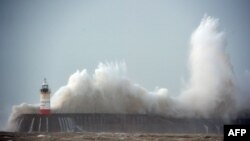A new United Nations report finds that climate change and El Nino had a strong influence on natural disasters in 2015. It says these phenomena affected both the number and intensity of droughts, floods and other weather-related hazards around the world.
The U.N. Office for Disaster Risk Reduction says 32 major droughts were recorded in 2015. This is more than double the 10-year annual average. The impact was particularly serious in sub-Saharan Africa.
The Belgium-based Center for Research on the Epidemiology of Disasters compiles the data on earthquakes, drought, floods, cyclones and other global natural disasters. After reviewing the data, the center’s director, Debarati Guha-Sapir declares 2015 to be the year of the drought.
“Over 50 million people are now affected. This will get worse in 2016. We are going to face a humanitarian disaster in 2016 and there will be a movement of population of migration.”
Drought
Africa last encountered severe drought in 2011, when a lack of rain in the Horn of Africa displaced about 12 million from their homes, and killed an estimated 260,000 people in Somalia.
Guha-Sapir warns droughts are the disasters that have the most persistent impact on human development.
“Drought leads to severe malnutrition in small children and severe malnutrition of small children lead to their deaths within four to six weeks," Guha-Sapir said, adding that there were early warnings of the disaster in 2011, but governments did not pay attention.
She says governments should not repeat that mistake now and wait for the United Nations to declare a famine before taking action.
Guha-Sapir warns once a famine is declared, it will be too late to turn the disaster around.






